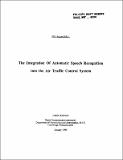The integration of Automatic Speech Recognition into the Air Traffic Control system
Author(s)
Karlsson, Joakim
DownloadFTL_R_1990_01.pdf (6.430Mb)
Alternative title
Integration of ASR into the ATC system
Other Contributors
Massachusetts Institute of Technology. Flight Transportation Laboratory
Metadata
Show full item recordAbstract
Today, the Air Traffic Control (ATC) system relies primarily on verbal communication between the air traffic controllers and the pilots of the aircraft in the controlled airspace. Although a computer system exists that processes primary radar, secondary radar, and flight plan information, the information contained within the verbal communications is not retained. The introduction of Automatic Speech Recognition (ASR) technology would allow this information to be captured for processing. The research presented in this paper examines the feasibility of using ASR technology in the Air Traffic Control environment. The current status of the technology is assessed. Problems that are unique to ATC applications of voice input are identified. Since ASR technology is inherently a part of the man-machine interface between the user and the system, emphasis is placed on the relevant human factors issues. A man-machine model is presented which demonstrates the use of mixed input modalities, automatic error detection and correction techniques, and the optimal use of feedback to the controller. Much of the potential benefit of introducing ASR technology into the Air Traffic Control system is a result of the highly constrained language used by air traffic controllers. Consequently, the information content of the ATC language must be determined, and methods must be designed to process the various levels of knowledge inherently available in ATC communications. The man machine model adopted in this paper demonstrates techniques to utilize syntactic, semantic, and pragmatic information to improve overall recognition accuracy. An intelligent, adaptive voice input parser is presented.
Description
January 1990 Also issued as an M.S. thesis, Massachusetts Institute of Technology, Dept. of Aeronautics and Astronautics, 1990 Includes bibliographical references (p. 89-94)
Date issued
1990Publisher
Cambridge, Mass. : Flight Transportation Laboratory, Dept. of Aeronautics and Astronautics, Massachusetts Institute of Technology, [1990]
Other identifiers
21336744
Series/Report no.
FTL report (Massachusetts Institute of Technology. Flight Transportation Laboratory) ; R90-1
Keywords
Air traffic control, Automatic speech recognition, Automation